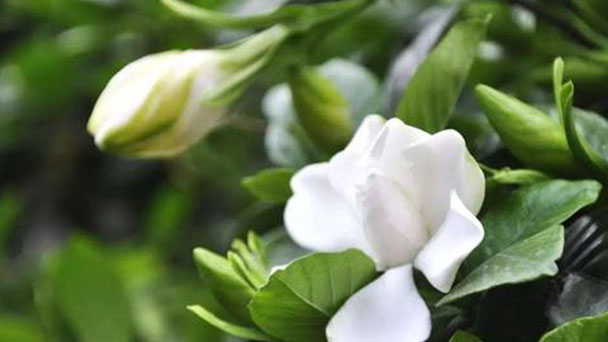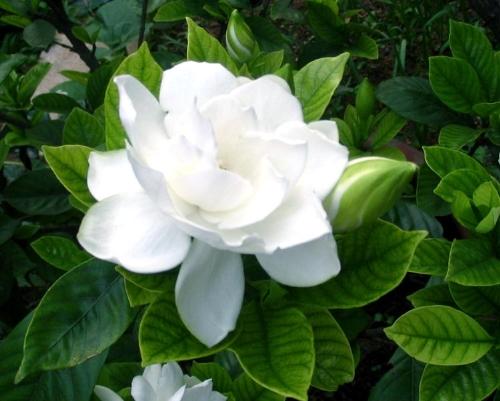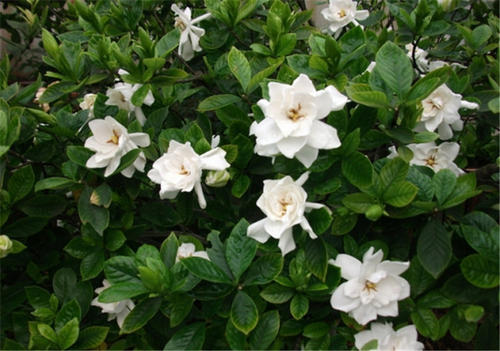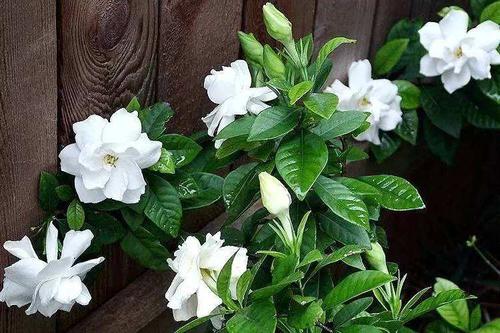Cape jasmine profile
Written by Maggie
Oct 13 2021

Cape Jasmine, scientific name Gardenia jasminoides, is an evergreen shrub, prefers warm moist and sunny environment, hardy to cold, tolerant to semi-shade, afraid of standing water, requires loose, fertile and acidic sandy loam, native to China. Cape Jasmine is an important garden ornamental plant with luxuriant leaves, evergreen leaves and fragrant and elegant flowers. In addition to ornamental, its flowers, fruits, leaves and roots can be used as medicine, have the effect of reducing fire in addition to irritation, clearing heat and diuresis, cooling blood and detoxification.
Cape Jasmine Picture

Cape Jasmine Characteristics
Cape Jasmine Stems
Cape Jasmine is an evergreen shrub, 1 -- 3m tall. Dry gray, branchlets ARE green, with scaly hairs.
Cape Jasmine Leaf
Cape jasmine leaves are opposite, leathery, thin as paper, less 3 verticillate, leaf form is diversiform, usually to oblong-elliptic lanceolate, oblong, obovate or elliptic, oval 3-25 cm long, 1.5 8 cm wide, apex long acuminate, abruptly acuminate or acute and obtuse, base cuneate or acute, often glabrous on both sides, the bright green, the complexion dark; Lateral veins are 8-15 pairs, raised below, flat above; Petiole is 0.2-1 cm long;Stipules membranous.
Cape Jasmine Flowers
The flowers of cape jasmine are aromatic, usually solitary at the top of branches, pedicels 3 -- 5 mm long; Calyx tubes are obconic or ovate, 8 -- 25 mm long, longitudinally ribbed, calyx eaves tubular, enlarged, apically 5-8 lobed, usually 6-lobed, lobes lanceolate or linear-lanceolate, 10 -- 30 mm long, 1 -- 4 mm wide, fruited, persistent; Corolla is white or creamy yellow, albicular, pubescent at throat, crown tube narrowly cylindrical, 3-5 cm long and 4-6 mm wide, apically 5 to 8 lobed, usually 6 lobed, lobes spreading, obovate or obovate-oblong, 1.5-4 cm long and 0.6-2.8 cm wide; Filaments are very short, anthers linear, 1.5-2.2 cm long, protruding; Styles are stout, ca. 4.5 cm long, stigmas fusiform, protruding, 1 -- 1.5 cm long, 3 -- 7 mm wide, ovary ca. 3 mm in diameter, yellow, smooth.
The flowering period of Cape Jasmine is from March to July.
Cape Jasmine Fruit
Fruit of Cape Jasmine is ovate, subglobose, elliptic or oblong, yellow or orange-red, 1.5 -- 7 cm long, 1.2 -- 2 cm in diameter, with 5 -- 9 winglike longitudinals, apically persistent sepals up to 4 cm long and 6 mm wide; Seeds are numerous, oblate, suborbicular but slightly angular, ca. 3.5 mm long, ca. 3 mm wide.
Fruit season of Cape jasmine from May to February of the following year.
Cape Jasmine Origin
Cape Jasmine is originally produced in China and cultivated in most parts of the country. It is concentrated in most areas of eastern China, southwest and central and central China, including Fujian, Guizhou, Zhejiang, Jiangsu, Jiangxi, Hubei, Hunan, Sichuan, and southern Shaanxi provinces. The city flower of Changde in Hunan province is Cape Jasmine. The city flower of Yueyang in Hunan province is Cape Jasmine.
Cape Jasmine Native Habits
Cape Jasmine likes a warm, humid, well-lit and well-ventilated environment, but it is not exposed to strong light. It is suitable for living in a slightly shaded place, tolerant to semi-shade, afraid of standing water, and cold resistant. In northeast, north and northwest China, Cape Jasmine can only be used as greenhouse potted flowers. Cape Jasmine is suitable to use loose fertile, good drainage of light viscous acid soil planting, is a typical acid flower. It can be propagated by cutting, layering, dividing or sowing.
Cape Jasmine Care
Soil
Cape Jasmine is an indicator plant for acidic soils, so the slightly acidic environment of the soil is the key to the growth of Cape Jasmine. The culture soil was a mixture of slightly acidic sandy laterite and leaf saprolite. It is advisable to control the pH value of the soil between 4.0 and 6.5.
Temperature
The optimum growth temperature in Cape Jasmine is between 16℃ and 18℃. Low temperature and direct sunlight are extremely detrimental to the growth of Cape Jasmine. Therefore, it is advisable to conserve Cape Jasmine in the open forest or shade shade with good ventilation, high air humidity and transparent light in summer. Winter in the sun, the temperature is not lower than 0℃ environment, let it dormant, the temperature will affect the next year's flowering.

Moisture
Cape Jasmine likes humid air, and water should be added moderately during the growing season. Usually the basin soil can be white water, thoroughly pouring. Summer is hot, every day to foliar spray 2-3 times, in order to increase air humidity, help plants cool down. But after the flower is bud, watering should not be too much, so as not to cause falling bud.Winter watering with partial dry had better, prevent water root rot.
Fertilizer
Cape Jasmine is a fat-loving plant. In order to meet its growing needs and maintain a slightly acidic soil, Ferric Sulphate can be mixed into the fertilizer solution for fermentation. After entering the growth season in April, we can apply top dressing every half a month (fertilization when it is best to add some water, in case of burning). This will not only meet Cape Jasmine's needs for fertilizer, but also keep the soil in a relatively balanced acidic environment to prevent the occurrence of chlorosis, as well as avoid the damage to Cape Jasmine caused by accidental ferrous sulfate supplement and local excessive acid.
Cape Jasmine Disease
Cape Jasmine is frequently prone to leaf yellowing and leaf spot, which is sprayed 600 times with 65% Zinc WP. The insect pests were acanthophora moth, scale insect and mealworms. The acanthophora moth was sprayed with 2.5% enemy killing emulsion 3000 times, and the scale insect and mealworms were sprayed with 40% oxidized dimethoate emulsion 1500 times.
Yellowing disease
The occurrence is more common, caused by a variety of reasons. It is necessary to take different measures to prevent and control the general application of decayed human excrement or cake fertilizer.
Young leaves between the veins of the loss of green and yellow, seriously will make the whole plant leaves yellow, and even coke leaves and branches withered, and finally cause the plant death. In this kind of situation, we can spray 0.2% ~ 0.5% ferrous sulfate aqueous solution for prevention and control. The chlorosis caused by magnesium deficiency gradually develops from the old leaves to the new leaves, and the veins are still green. In severe cases, the leaves fall off and die. In this kind of situation, we can spray 0.7%, 0.8% boron magnesium fertilizer prevention and control. Overwatering, freezing and so on, will also cause the phenomenon of yellow leaves, so in the maintenance process to pay special attention to. The appearance of nitrogen deficiency is simple yellow leaves, and the new leaves are small and crisp. Potassium deficiency appears as the green to brown color of old leaves. Phosphorus deficiency is manifested as purplish red or dark red in old leaves.
Soot disease
Soot disease occurs in branches and leaves. After discovery usable clear water is swabbed, or gush 0.3 wave beauty spends stone sulfur mixture, 1000 ~ 1200 times much fungus is clever.
Rot
Rot often occurs in the lower trunk, stem bulging, cracking, immediately after the discovery of scraping or coating 5 ~ 10 degrees of sulfur mixture, several times can be effective.
Insect pests
The pests that plague Cape Jasmine are aphids, hoppers and horsetail moth larvae, the first two of which can be controlled by dimethyl fruit and trim trites, the latter of which can be controlled by 666 powder or captured manually.
Pest and disease control in Cape Jasmine. In addition, in the winter of Cape Jasmine, when the indoor ventilation is poor and the temperature and humidity are too high, the harm of scale insects is prone to occur, accompanied by the occurrence of soot disease. Scale insects can be scraped off with a bamboo stick or a small brush, and can also be sprayed with 20 oil emulsion plus 100 ~ 150 times water. Soot disease can be swabbed with clear water, or with polyfungalim 1000 times liquid spray prevention and control.
Cape Jasmine Benefits
Improve the environment
The impact of Cape Jasmine on the home environment
Its appearance makes you feel impeccable. We always say that Cape Jasmine is a good place to be. How is it a good place to be to be?Cape jasmine leafy, color the four seasons evergreen leaves and flowers fragrant simple but elegant, green white flowers, very beautiful and lovely, for good in the courtyard landscaping materials. It is suitable for the order before and poolside and roadside configuration, also can be used as a hedge, and potted ornamental plants, flowers may also do the flower arrangement and wear decoration.
2. It can let the household environment produce qualitative change. The most distinctive feature of a Cape Jasmine is its fragrance of flowers. If one plant is planted in your home, it can be smelled from hundreds of square meters around. Just imagine, in your home, you have a space of about 100 square meters.
3. It has a great effect on beautifying your home. If you put a Cape Jasmine plant next to your TV at home, it will beautify the indoor space and absorb the harmful radiation, but also emit a fragrance from time to time, which will mask the original plain or even unpleasant smell, exchange air for the space, and make the whole home full of poetry.
Daily chemical
Cape Jasmine contains benzyl acetate, linalool acetate, ethyl ethyl thyroxylostyl acetate and other components. The extraction method of Cape Jasmine can be used to produce Cape Jasmine extract. The extraction rate of Cape Jasmine extract is 0.1-0.13%. It can be widely used in cosmetics and food flavors. Cape Jasmine oil can be produced by steam distillation. The oil yield is about 0.02%. Cape Jasmine Oil can be used to prepare a variety of floral perfumes, soaps, and cosmetics fragrances.In addition, the benzyl acetate and linalool acetate of Cape Jasmine oil can be isolated by decompressed-pressure fractionation as the main deodorant or harmonizer commonly used in daily cosmetics. It is also commonly used in the flavor of food such as chewing gum.

Read Next:
Cape Jasmine (Gardenia Jasminoides) Care & Propagation Guide
Latest Updated
- Benefits of Bugleweed - 7 Science-backed Health Benefits
- Bugleweed Dangers & Side Effects - Is It Poisonous?
- How to Plant Evergreen Trees - What You Should Know
- When to Plant Evergreens - Grow Guide for Evergreen Trees
- 12 Wonderful Evergreen Shrubs for Your Garden
- 12 Popular Evergreen Plants with Pictures for Beginners
- When And How To Prune A Lilac Bush Like a Pro
- How to Grow & Care for Lilac Vine (Hardenbergia Violacea)
- Japanese Lilac Tree (Syringa Reticulata) Care & Propagation Guide
- Shumard Oak Pros and Cons - What to Know
Popular Articles
- Winter maintenance of Antirrhinum Majus
- How to Grow Terminalia Mantaly Tree
- How to Grow and Care for Crossostephium Chinense
- How to grow Antirrhinum Majus in spring
- Peristeria Elata (Dove Orchid) Profile: Info & Care Guide
- Underwatered Snake Plant (Sansevieria Trifasciata) - Signs And How To Fix
- How to Care for Brazilian Jasmine Plant (Mandevilla Sanderi)
- How to Grow & Care for Graptopetalum Purple Delight in Summer
- Rosa Chinensis (China Rose): Plant Growing & Care Tips
- How to Care for Baby Sun Rose (Aptenia Cordifolia)